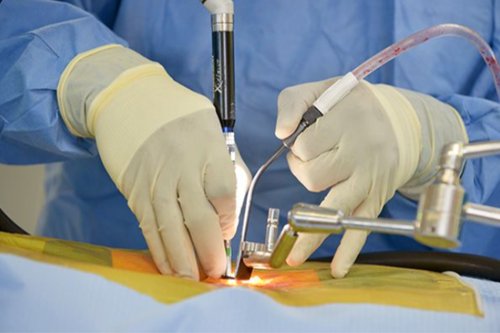Dr. Paresh Bang | Matruchhaya Spine Clinic
Meet Our Doctor
Dr. Paresh Bang
Consultant Spine Surgeon

Minimally Invasive Spine Surgery In Akola

Minimally Invasive Spine Surgery (MISS) refers to surgical procedures designed to treat spine conditions with minimal damage to surrounding tissues. Unlike traditional open surgery, which requires larger incisions and extensive muscle retraction, MISS aims to reduce the impact on the body, leading to faster recovery times, less pain, and reduced hospital stays. This technique is particularly useful for conditions such as herniated discs, spinal stenosis, scoliosis, and some types of spinal tumors.
Key Goals of Minimally Invasive Spine Surgery In Akola
Reduce tissue damage: By minimizing the size of the incision and the need to cut through muscles, MISS avoids the extensive tissue trauma associated with traditional spine surgery.
Decrease recovery time: Smaller incisions mean faster healing times and quicker return normal activities.
Less postoperative pain: Since there is less muscle and tissue disruption, patients often experience less pain after surgery.
Lower risk of infection: Smaller incisions reduce the risk of postoperative infections and other complications.
Conditions Treated with Minimally Invasive Spine Surgery:
MISS can be used to treat various spinal conditions, including:
- Herniated or bulging discs
- Degenerative disc disease
- Spinal stenosis (narrowing of the spinal canal)
- Spinal instability
- Scoliosis and other spinal deformities
- Spinal fractures (from trauma or osteoporosis)
- Spondylolisthesis (slipped vertebra)
- Tumors of the spine
- Spinal infections
Common Techniques Used in MISS
MISS is achieved through various techniques, each tailored to specific spinal conditions. Common techniques include:
Endoscopic spine surgery: A small tube with a camera (endoscope) is inserted through a small incision to visualize the spinal structures. Tiny instruments are used to perform the surgery through the tube.
Percutaneous instrumentation: This involves inserting screws, rods, or cages through small incisions to stabilize the spine. These instruments are placed using imaging guidance, such as X-rays or fluoroscopy.
Minimally invasive decompression: This procedure involves removing small portions of bone or herniated disc material that may be compressing spinal nerves. It is commonly used for treating conditions like spinal stenosis or herniated discs.
Minimally invasive spinal fusion: Small incisions are made, and screws or rods are inserted to stabilize the spine. A bone graft is placed to promote fusion between vertebrae, which helps to eliminate painful motion in cases like degenerative disc disease or spondylolisthesis.
Lateral Interbody Fusion (XLIF): This technique approaches the spine from the side of the body, avoiding large muscles in the back and providing a minimally invasive option for lumbar spine fusion.
Conditions Treated with MISS
Some of the common conditions treated with MISS include:
Herniated discs: Disc material that presses on nerves can be removed with minimal disruption to surrounding tissues.
Spinal stenosis: Narrowing of the spinal canal can be relieved by removing small portions of bone or tissue through a small incision.
Degenerative disc disease: MISS can stabilize affected segments of the spine with minimally invasive fusion techniques.
Spondylolisthesis: This condition, where one vertebra slips over another, can be treated using minimally invasive spinal fusion techniques.
Spinal deformities: Scoliosis and kyphosis can be addressed with minimally invasive procedures to correct alignment and provide stabilization.
How MISS is Performed
MISS procedures are typically done under general anesthesia, but the specific steps vary depending on the surgery type. Key steps include:
- Small incisions: Instead of a large incision, surgeons make small cuts, often less than 1 inch in length.
- Tubular retractors: Surgeons use special tubular retractors to create a small working channel through which they can pass surgical tools, reducing the need to cut through muscles.
- Microscopy and endoscopy: High-powered microscopes or endoscopic cameras provide surgeons with a clear, magnified view of the surgical area.
- Real-time imaging: Technologies like fluoroscopy (live X-ray) or intraoperative CT scans guide the surgeon in placing instruments or hardware accurately.
Benefits of MISS
- Less blood loss during surgery.
- Smaller scars due to smaller incisions.
- Reduced hospital stays: Many MISS procedures are done on an outpatient basis, allowing patients to go home the same day.
- Quicker recovery: Patients typically return to work or normal activities faster than those who undergo traditional open surgery.
Risks and Limitations Minimally Invasive Spine Surgery:
While MISS offers many advantages, there are some risks and limitations:
Technical complexity: MISS procedures require specialized training and experience. Not all spinal surgeons are proficient in these techniques.
Not suitable for all patients: Some complex spinal conditions, like severe deformities or multiple-level disc problems, may still require traditional open surgery.
Complications: Though the risk is reduced, complications such as infection, bleeding, nerve damage, or incomplete resolution of symptoms can still occur.
Recovery After Minimally Invasive Spine Surgery
Recovery following MISS is generally faster and less painful than with traditional surgery. Key aspects include:
Shorter hospital stay: Many patients are discharged the same day or after 1-2 days of observation.
Quicker mobilization: Patients are encouraged to start moving as soon as possible to prevent complications such as blood clots.
Physical therapy: In some cases, patients may require physical therapy to strengthen their muscles and regain mobility.
Reduced use of pain medication: Due to the minimally invasive nature of the surgery, less pain medication is typically required.
Conclusion:
Minimally Invasive Spine Surgery has revolutionized the way spine disorders are treated, offering a safer, less painful alternative to traditional surgery. The precise techniques and advanced technology used in MISS lead to faster recovery times, less postoperative pain, and a quicker return to everyday activities. However, it’s essential to consult with an experienced spine surgeon to determine if MISS is the right option for a particular condition.
